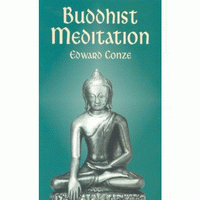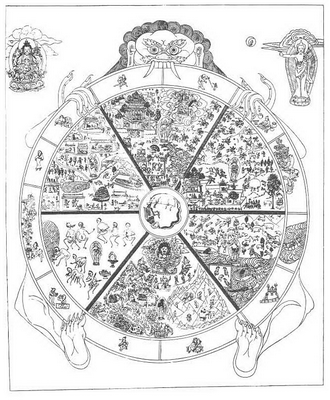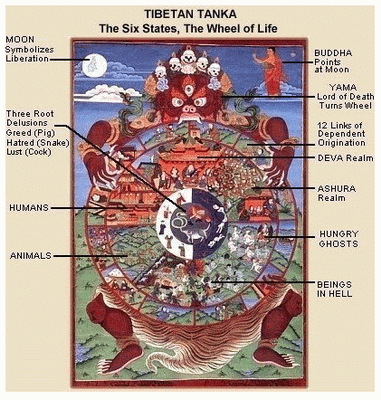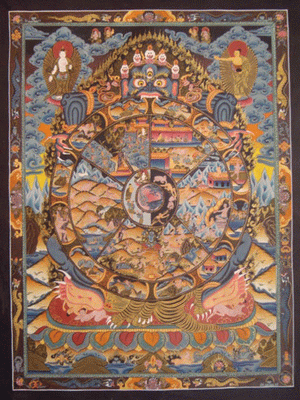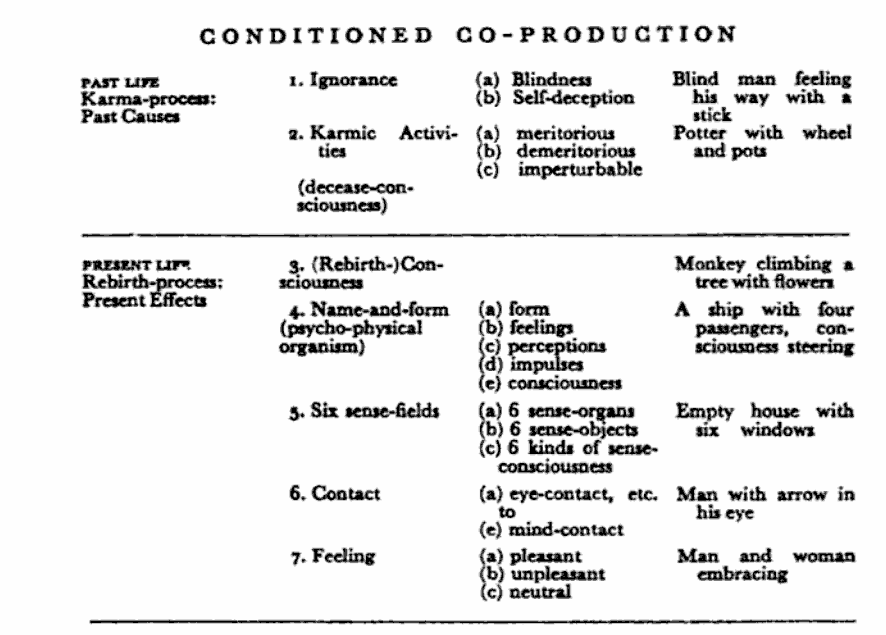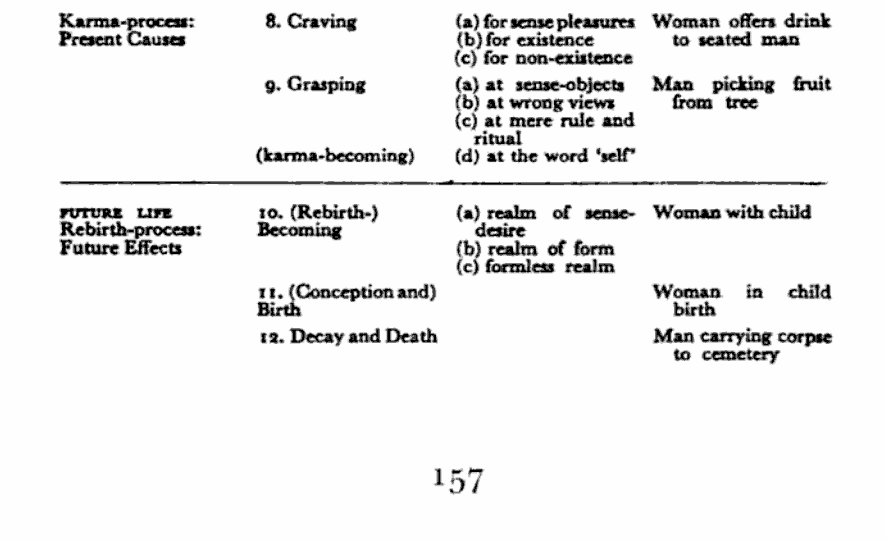Conze Buddhist Meditation p. 157
|
Past Life
Karma-process:
Past Causes
|
Ignorance
Avidya (Skt), Ma-rig-pa (Tb)
|
A blind person
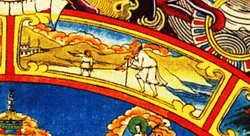
|
Avidya is the lack of wisdom. It is not just that people
haven’t learned some fact that they need to know, but rather
rather that their habitual ways of perceiving the world are
fundamentally mistaken, and thus they are “blinded”.
|
|
Blinded by the Illusion of self or ego – a sense of
separateness
|
This nidana represents the very beginning of the
formation of ‘I’ and ‘other’. ‘I’ and ‘other’ arise together
and with dependence on each other. The formation and
relationship between ‘I’ and ‘other’ occurring in an
atmosphere of ignorance leads to the ever-recurring
conceptual phantoms that rule the life of being in
samsara
(ocean of suffering).
|
The formation of the seed of ‘I’ and ‘other’ begins with
the sense of overcrowdedness of the energies and textures of
mind-body materials “stirred up by basic intelligence”.
The sense of claustrophobia leads to adouble-take/panic,
momentarily freezing everything.
|
Basic intelligence and unconditional space are still
there. Being aware of the contrast between space and frozen
space causes more panic and bewilderment.
|
|
|
Karmic Activities
|
A potter making pots.
|
In Indian philosophy, pots are common images–they come
into being when they are made, get broken, and in between
are useful everyday items. These karmic formations
(particularly the deeply embedded idea of having a “Self,”
the activity of body, speech and mind, as well as more
individual tendencies and predispositions) are important
factors in forming a personality (and like pots, they are
subject to change over time).
|
|
|
|
|
|
|
|
|
3. Consciousness (vijnana)
A monkey scampering across a rooftop.
|
The monkey is one of the traditional images for human
consciousness–just as monkeys run here and there (sometimes
seemingly aimlessly), in the same way human consciousness
wanders as the objects of perception (physical and mental)
change.
Connecting a consciousness (of something) with ideas of a
Self is the work of the samskaras.
|
|
|
|
|
|
|
|
|
4. Name and Form (nama-rupa)
Two Men in a Boat
|
“Form” refers to the physical component of a person’s
experience (the body), and “Name” to the non-physical
components (sensation, feeling, samskaras, and
consciousness). Both of these elements exist in one
personality, just as the two separate men are both in the
boat. For Buddhists, the error is in supposing that Name and
Form are components of some unchanging, continuous personal
Self (which Buddhists deny exists, since all components of
personality are changeable).
|
|
|
|
|
|
|
|
|
5. The Six Senses (shadayatana)
A house with six windows.
|
The six senses are sight, hearing, smell, touch, taste,
and the mind (which perceives and processes mental objects).
As our source of sense data, they are clearly involved with
our interactions with the world.
|
|
|
|
6. Contact (sparsha)
A couple making love.
|
The activity of the sense organs brings one into contact
with the objects in the world (if there were no sense
organs, or one was deficient, this would be impossible).
|
|
|
|
7. Feeling (vedana)
A man with an arrow in his eye.
|
Contact gives rise to feelings of attachment and
aversion, depending on the nature of the contact (this
particular example gives me the creeps).
|
|
|
|
8. Craving (trshna)
A picnic (eating and drinking)
|
When one has generated mental feelings based on the
sensations given by the sense organs, one will desire to
obtain the pleasant ones, and to avoid the unpleasant ones.
This then can become reinforced into habitual patterns of
attachment and aversion.
|
|
|
|
9. Grasping (upadana)
A monkey picking fruit.
|
Once one has developed desires to obtain something (or to
avoid something), one takes concrete steps to try to get
it.
|
|
|
|
10. Becoming (bhava)
A pregnant woman (this is the traditional explanation for
the image for this stage, because this woman doesn’t look
very pregnant to me).
|
Once one purposefully strives to gain (or to avoid)
things, this pattern of intentional activity sets up the
operation of karma, which lays down causes whose effects
become manifest in the present and future lives.
|
|
|
|
11. Birth (jati)
A woman giving birth.
|
One’s karmic activities lead to rebirth in a state that
reflects the quality of that karma.
|
|
|
|
12. Old Age and Death (jara-marana)
A corpse being carried away (and bodies on the
ground).
|
Once one is born, death is inevitable. Old age can be
avoided by dying young, but few people are hot to do this.
Old age, illness, and death are a shorthand rendition of the
problems that afflict human existence, and to which the
Buddha was trying to find an answer.
|
